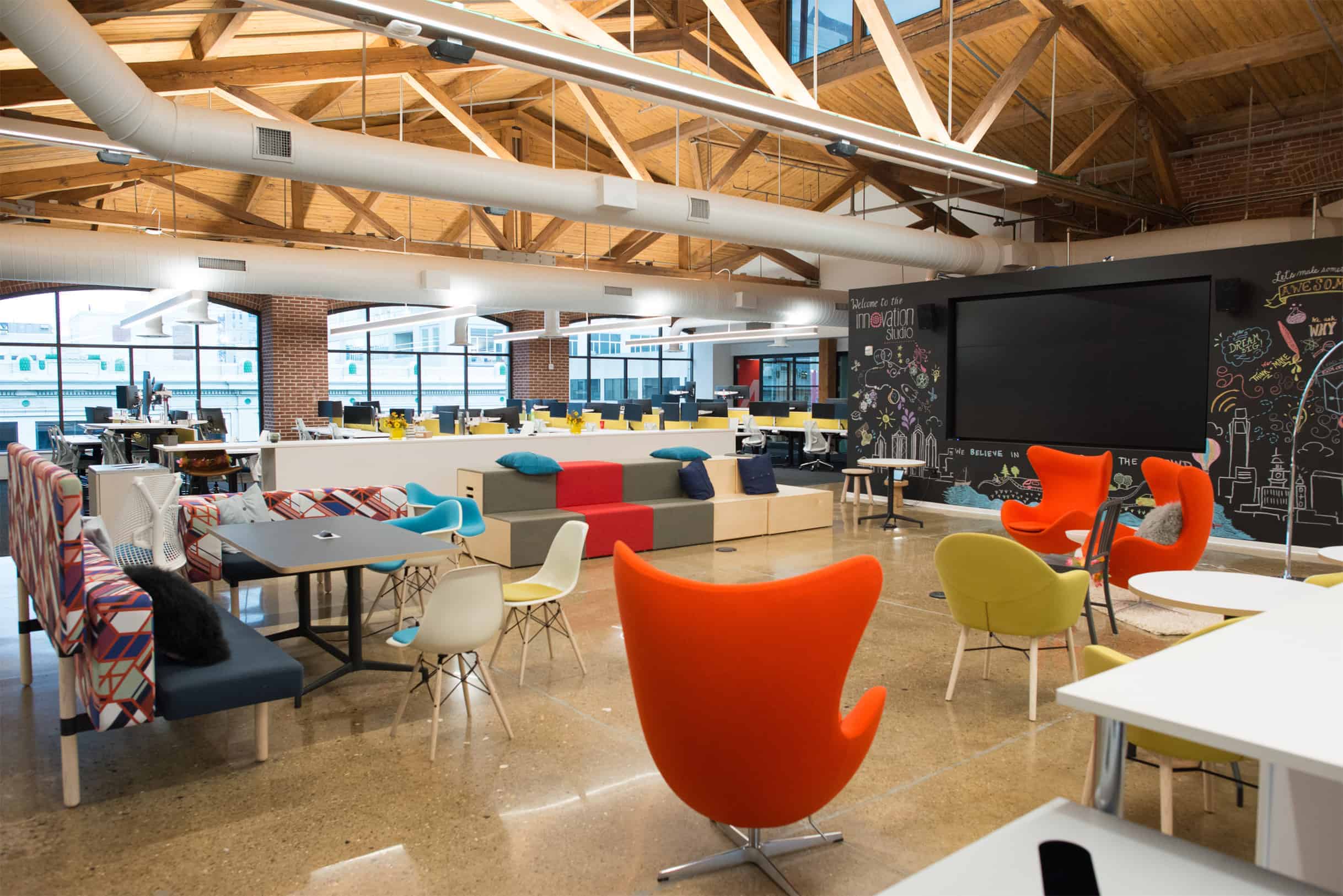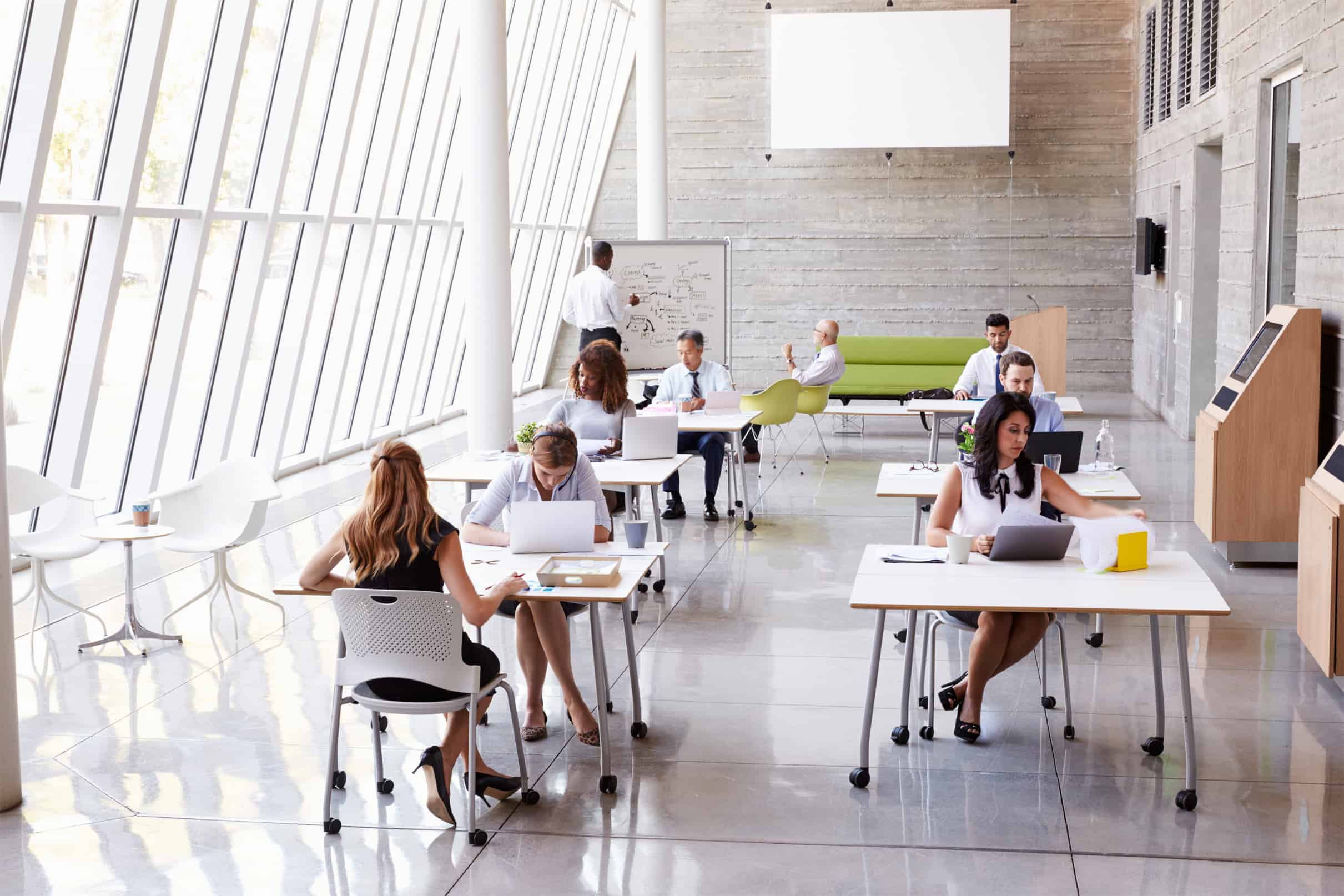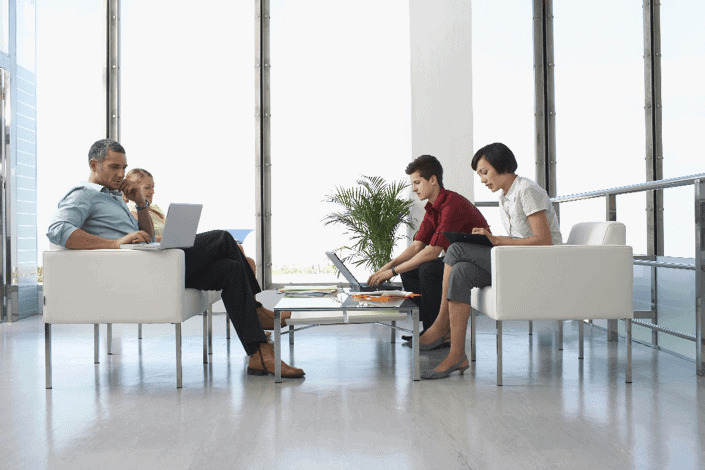Modern Office Design Concepts: Changing The Open-Office Trend
Just about anyone working in business today is familiar with open-office design. Rather than carving up offices with cubicles or walls, the open-office concept seats employees together in open, communal workspaces.
Decades ago, the open-office concept became the big trend for American offices, replacing older floor plans that often consisted of private offices around the perimeter with row upon row of cubicles on the inside. In their heyday, open offices had long rows of desks with little privacy and personal space. The design has since evolved to include additional and more-varied workspace options such as private phone booths, standing desks, and lounge areas.

Technological advancements slowly ushered in a shift toward remote work which, as the COVID-19 pandemic hit in 2020, abruptly became the new normal. These workforce changes are now influencing the next evolution of open-offices layouts. Many companies are designing flexible, hybrid workspaces that acknowledge these changes and allow employees to work both in-person and remotely.
In this blog, we explore the open-office design concept in detail, discuss the pros and cons of the design, and present some solutions for redesigning an office space to create something more suitable for the needs of a modern business.
What is the open-office design concept?
The open-office design concept proposes floor plans that arrange office spaces to have minimal or no physical barriers, allowing for more collaboration and interaction among employees. This design concept has been popular since the 1950s but has undergone changes over the years. First developed in Germany during the mid-20th century, open-office plans really took root in the United States during the early 2000s, gaining traction among East Coast creative agencies, Silicon Valley tech firms, and other forward-thinking companies. Today, the open office may be the norm: roughly 70% of American offices use an open floor plan.

The Pros and Cons of an Open-Office Design
As open offices became more established, however, cracks in the design began to show. While the concept’s proponents contend that it encourages collaboration, camaraderie, flexibility, and comfort, employees complain about distractions, lack of privacy, and feeling exposed in the workplace. Moreover, studies appear to disprove many of its touted benefits, indicating that open offices can actually lead to lower productivity, less collaboration, and damaged employee morale. Most notably, the Harvard Business Review published a powerful study and analysis on this topic, “The Truth About Open Offices.”
How much truth was there ever really behind many of the supposed productivity and collaboration benefits tied to open-office layouts? Was it always just a cost-saving move to help businesses pack more workers into less office space? Were the other benefits simply a facade to justify moving to an open floor plan and reducing real estate overhead? Or did the open-office concept deserve to take the place of the closed floor plan?
As the younger generation of talent questions the design of the open office concept, employers strive to find new designs that keep them competitive in the current business climate. Over the last several years, designers have tested a variety of new design concepts that aim to avoid the negatives of open-office floor plans while optimizing their benefits. This process was in its infancy when COVID-19 hit in 2020, adding more challenges for businesses and office design and furniture vendors to solve.
Next, we talk more about the pros and cons of open-office floor plans and discuss promising alternatives to their one-size-fits-all approach. But first, check out these 5 Things to Help You Survive an Open-Plan Office.
Pros
Open offices were introduced to correct the limitations of private-office or cubicle-reliant designs in an evolving business culture. It turned out that separating employees from each other stifled their ability to collaborate and promoted an unhealthy, individualistic office culture. Supporters of the open-office design, mostly management-level employees, believe that it solves these problems in many ways:
Collaboration
Fewer barriers between team members make for a more collaborative environment. Employees isolated in private workspaces may not see themselves as part of a team or may feel discouraged from seeking a coworker’s input or advice.
Communication
Similarly, physical barriers create idea barriers. Employees are less likely to communicate when doing so requires extra effort and inconvenience.
Camaraderie
Proponents argue that working in a shared space creates the feeling that employees are in it together, rather than independently pursuing their given tasks. As private offices can often impart a certain prestige or status, employees should feel that they are working as a team, not competing against each other for the better workspace.
Cost Effectiveness
Furnishing open workspace costs less per person and per square foot than carving out private workspaces. It also makes it easier to streamline IT infrastructure.
Managers More Accessible
Eliminating private offices reduces the intimidating feeling of walking into the boss’s office. When supervisors aren’t separated by closed doors, they become more approachable.
Easier Team Supervision
Just as open-office designs make managers more accessible to their teams, they make the teams more accessible as well, allowing for more efficient supervision.
More Flexible to Change
As companies expand or diversify, having an open floor plan allows for easier adjustments to suit new talent or accommodate more workspaces.
More Aesthetically Pleasing
Open offices look more “modern” than their stodgy predecessors and impart a forward-looking feel to the space.
More Comfortable
Open spaces allow air and light into the environment, putting people at ease.
It’s Trendy
Who wouldn’t want to follow the lead of that hip Brooklyn start-up or that Silicon Valley juggernaut?
Cons
As open-office plans have been broadly adopted, many employees have objections to the concept. Some features of the design have backfired, doing the opposite of what was intended as a benefit. In other cases, entirely unforeseen drawbacks have arisen. Here are some common complaints:
Collaboration vs. Distraction
While making employees more accessible to each can facilitate collaboration and communication, it can also be a frustrating distraction for talented employees who are trying to concentrate on a task. In some offices, this has become enough of a problem to warrant recognized “do not disturb” rules, e.g., when a team member is wearing headphones, leave him or her alone.
Less Privacy
Employees in open offices often feel exposed to coworkers for the entirety of the workday. Many people require at least a few moments of privacy during the day.

Micro-Management and Over-Supervising
Though many managers believe that open offices make them more accessible to their teams in a good way, employees often complain that they feel constantly watched over by management. This can lead to a stressful environment that ultimately puts pressure on an employee and stifles productivity.
Increased Conflict
Anyone who has ever had to spend too much time around siblings during a childhood vacation knows that overexposure creates conflict. This is true in the workplace as well as in families. The stress of constant exposure can cause irritability and lead to more heated disagreements among coworkers.
Spread of Germs
Increased contact means increased exposure to germs. The result is more sick employees, translating to lost productivity.
Job Dissatisfaction
All of these minor stressors can add up to an overall sense of unhappiness with the job, making it difficult for employers to retain their best talent.
Nowhere to Cry in Private
Okay, this con leans a bit toward parody, but sadly it may ring true for some people, as an extension of the lack of privacy. Enjoy this humorous article written by a comedian.
The Harvard Business Review Study of Open Workspaces
In the recent study “The Truth About Open Offices” cited earlier in this blog, researchers set out to measure empirically the effects of open offices on employee behavior. Do they really facilitate collaboration? Do they increase productivity? Do they boost morale?
To the contrary, what the researchers found was that “rather than prompting increasingly vibrant face-to-face collaboration, open architecture appeared to trigger a natural human response to socially withdraw from officemates and interact instead over email and IM.” In short, claims of increased collaboration, communication, and camaraderie were all wrong. Collaboration and morale were actually shown to decrease in an open workplace.
With this evidence, employers have begun to weigh the complaints of their employees more heavily against the accepted wisdom of open workspaces.
Talent Retention and The Way Forward from Open-Office Designs
Today, attracting and retaining talent has become the biggest overall driver of how businesses make key HR, office-design, and other decisions that impact workers. This wasn’t always the case. Decades ago, when the open office trend caught on, employers were optimizing for efficiency and productivity. Later, as companies became aware of employee dissatisfaction and burnout, the office-design mindset shifted toward optimizing for effectiveness. The most effective layouts were those that better balanced productivity with employee satisfaction. Now, the most important characteristic of an office is its desirability to work in. If employees want to be there, attracting and retaining talent is easier, and productivity follows.
What the open-office concept “got right,” at least in spirit, was the importance of talent in the workplace. The people within a company are the company’s most crucial resource. If employees are unhappy, they will leave for better opportunities. In many cases, that means better workplaces.
With evidence building that employees are not happy in open offices, if employers want to stay competitive they need solutions. Fortunately, there has been significant recent innovation in workplace design; new philosophies are emerging that address the drawbacks of the open office while maintaining its spirit of collaboration, flexibility, and employee morale. Described below are some approaches that have begun to gain traction.
See LinkedIn’s Hybrid Office Redesign – https://youtu.be/p_J3o8VU5rw
COVID-19 & Privacy Solutions
The biggest open-office complaint is the added distraction and lack of privacy that accompany fewer walls and barriers, as compared with the design of more closed offices. The pandemic has produced an even-more imperative reason to demand private workspace. Businesses must now find solutions to increase privacy in the open office. These circumstances do not mean that the open office is completely dead, but office designers must come up with inventive wants to divide the office space, (i.e. using phone booths, freestanding walls, bookcases), that maximize the pros and minimize the cons of that layout.
Furniture Solutions to Office Workspace Demands
As more companies and employees turn against the open-office trend, there is no single, clear solution in modern office design. Rather, every company requires just the right kind of flexible workspace that will fit its unique needs. Described below are options that your furniture dealer can provide that get the most out of your office space.
Collaborative Workspaces
Even as the one-size-fits-all open-office plan falls out of fashion, most companies still require spaces that facilitate open communication and collaboration. These spaces can be dedicated or flexible—a team that routinely works collaboratively may “own” a workbench where team members work alongside each other. Conference rooms or breakout areas may be available to other teams as they need them.
Getaway Spaces
One of the biggest problems with the open office is lack of privacy. Even in collaborative settings, it is important for employees to be able to work privately and without distraction. JCI recommends that offices have a suitable balance of “getaway” spaces, such as huddle rooms for private conferencing, independent workstations, and phone booths.
The Cubicle Comeback
As offices aim for more balance between open, collaborative areas and private spaces in which to focus with fewer distractions, the cubicle’s popularity is back and on the rise. Don’t call it a comeback!
Hybrid Workstations
An increasingly popular option that can accommodate a range of demands and preferences, hybrid workstations can go a long way to increase office flexibility. Dynamic workstations can provide space for multiple people or tasks as the workflow requires. They can also be arranged and rearranged quickly to handle multiple needs.
These options can be applied in almost limitless combinations to maximize the flexibility and productivity of an office. Work with your furniture dealer to decide just what kinds of workstations are appropriate for your company’s needs.
Agile Work Environments
Agile work environments allow employees to choose from a variety of work settings depending on what will best suit the task at hand. They may choose to finish up a lengthy report at a traditional desk, conduct a group project at a collaborative bench, or hold a brainstorming session in a breakout space.
Many employees enjoy a sense of autonomy in an agile work environment when they have the ability to choose the workspace that suits their needs and when privacy is always an option. Agile work environments do have challenges, however. The system only works if it is implemented office-wide. For this reason, moving to an agile work environment requires an entire culture shift in companies moving away from an open office or traditional floor plan.
Activity-Based Workspaces
Activity-based workspaces are offices in which different spaces are set up to accommodate different tasks. These spaces work well in agile work settings as well as in team-based work environments where teams use or “own” workspaces that meet their needs. Desks and workbenches facilitate individual or collaborative productivity; group spaces, such as huddle rooms or breakout areas, host closed meetings or laid-back pitch sessions; phone booths offer privacy and focus to a client call.
Like the agile work concept, activity-based workspaces can increase productivity and employee autonomy. However, they are not necessarily suitable for every job or role. The most successful activity-based workspaces are designed with careful consideration for the needs of employees.

Unassigned Seating
Also known as “hot-desking” and very similar to the concept of “hoteling,” unassigned seating is another rising trend in contemporary offices. With this plan, employees are not assigned permanent desks or work areas. Instead, workstations are available on a first-come, first-served basis. This scheme can provide flexibility that is similar to an agile or activity-based workspace; unassigned seating can be combined with either, too. It also optimizes space and promotes a clean-desk environment. Unassigned seating works best in offices where people frequently work remotely. However, this model can be frustrating to employees who require or even prefer a certain amount of routine and ownership over their work environment.
Goodbye Open Office, Hello Balance
The open-office floor plan rose to prominence quickly, but its time seems to be coming to an end. Companies are finding that this plan, developed to increase collaboration, has a tendency to stifle productivity and make employees unhappy. If companies want to stay competitive and retain top talent, they need to find better, more flexible options in office design. As the decline of the open office shows, there is no single solution to the challenge of the ideal workspace. By working closely with a furniture dealer, companies can find just the right balance of collaborative, private, and dynamic workspaces to keep employees happy and productive.


